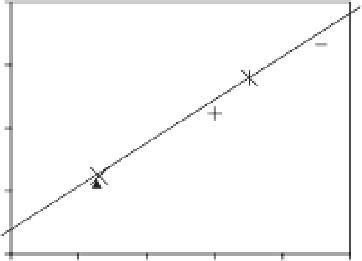Agriculture Reference
In-Depth Information
was found for a ramie sample (10.7%), while for
Crotalaria
('sunn hemp') a difference of 12%
was observed.
125
100
75
10.3.3 Using density values for
strength calculation
50
Well-documented studies of the mechanical
properties of natural fibre reinforced compos-
ites lead to the conclusion that it is very impor-
tant to know the exact density, because then it
is possible to calculate precisely the fibre volume
content or the cross-sectional area of the fibres
and, subsequently, the composite properties
(Cichocki and Thomason, 2002; Madsen and
Lilholt, 2003). Globally, mechanical notations
for engineered parts are related mainly to the
surface; a common unit is N/mm
2
or MPa. The
measurement of fineness in the textile industry
is usually expressed in tex. This measurement is
convenient for fibre bundles like bast fibres that
do not have circular or nearly circular cross-
sectional areas. The gravimetric fineness meas-
urement method described above can be carried
out with simple equipment. Generally, a conver-
sion is made using a standard density value
taken from the literature. The disadvantage is
that no reliable data for calculation can be
achieved.
An accurate measurement can be
obtained by analysing the density of the sam-
ple. In this case, the volume of the lumen and
porosities will not be considered. This allows
a proper conversion from a mass-related to a
surface-related mechanical property. This
can be confirmed by the results of single-
element tensile tests realized with the auto-
mated miniature tensile tester Dia-Stron
plotted in Fig. 10.11. The mechanical values
and the cross section were measured for
each fibre type. The measured density was
used to calculate the mechanical strength in
cN/tex. The line shows the calculated mass-
related density values using a standard liter-
ature density of 1.45 g/cm
3
. A proper
conversion from mass-related values into
surface-related ones is not possible if only
such standard density values are available.
For materials with densities >1.45 g/cm
3
(e.g. lyocell, ramie), the surface-related
25
500
750
1000
1250
1500
1750
Strength, N/mm
2
Lyocell
Jute
Sisal
Flax A
Cotton
Flax B
Hemp
Ramie
Fig. 10.11.
Fibre tensile strength in terms of linear
density (cN/tex) versus a surface-related strength
(N/mm
2
)/single-element strength tests using
Dia-Stron.
mechanical properties will be underestimated.
For materials with lower densities (e.g. sisal),
the opposite is true.
10.3.4 Mechanical properties of natural
and man-made cellulose fibres
It has been shown that the mechanical proper-
ties of natural fibres are competitive with those
of glass fibres, especially as short fibre rein-
forcement in composites (Schwill
et al
., 2004).
Table 10.5 summarizes the mechanical values
of the tested fibres and fibre bundles. At first
glance, the wide distribution of the mechanical
values does not seem to allow any calculation
of the mechanical properties of, for example,
composites. In case of the bast fibre samples,
flax and hemp, the standard deviations (not
shown here) of strength and Young's modulus
are equal to or bigger than the mean values.
The reason for the wide strength distribu-
tion lies in various natural defects and prop-
erty variation. Ruys
et al
. (2002) observed in
plant fibres natural defects like cracks, holes,
regions of reduced cross-sectional area, dislo-
cation bands and miscellaneous irregularities
in shape. They point out that the breaking
operation results in a high level of defects in
individual fibres. The presence of these defects













